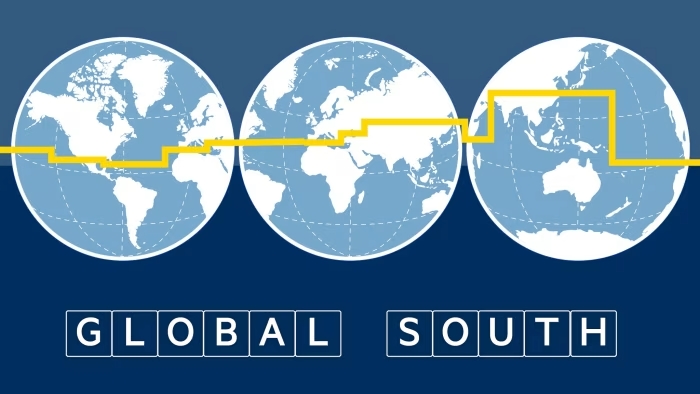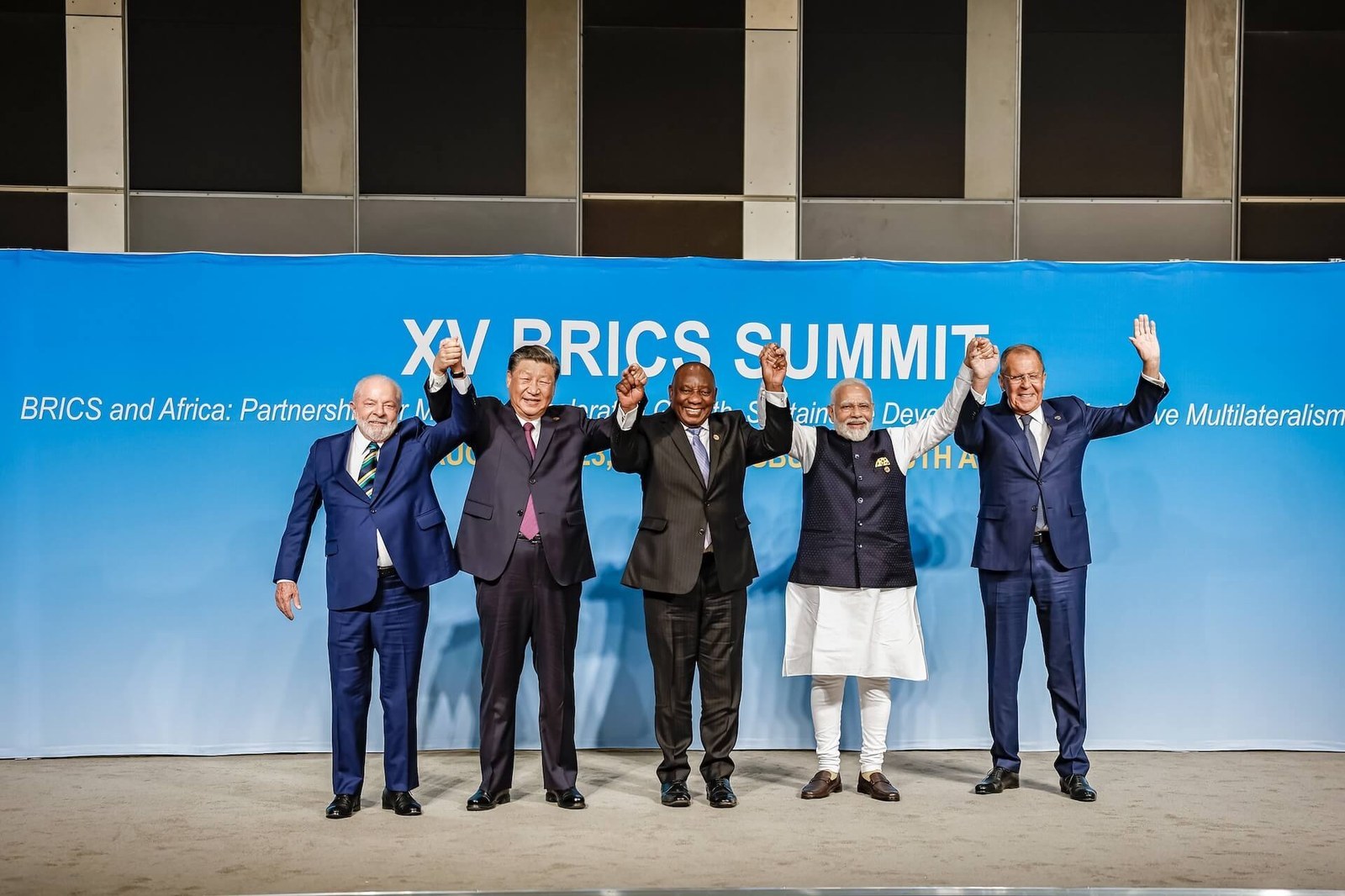The Global South has gone from a nebulous new buzzword to a true factor in determining the world’s relationships. Though far from a monolithic bloc, Global South states share some overlap in vision that will shape the near future in key areas.

(Graphic: Financial Times)
Renewed great power competition and the gradual rise of multipolarity put the Global South (GS) in the spotlight. From commodity suppliers and consumer markets to investment destinations and emerging manufacturing hubs, GS countries have huge potential and can alter the global balance of power. However, they also face governance challenges and flashpoints. For instance, the mineral-rich Democratic Republic of the Congo, which produces 73% of the world’s cobalt, has been plagued by internal conflict since the late 1990s. Other countries in West Asia and Africa also suffer from this so-called “resource curse.” The search for a development model suited to their peculiar conditions and avoiding the middle-income trap are among the challenges that beset the GS.
According to Deutsche Bank Research, the Global South accounts for a third of the world’s purchasing power parity-adjusted GDP, a quarter of global trade and inward foreign direct investment, 20% of real manufacturing value added, and almost two-thirds of the world’s labor force population. By 2030, it is projected that 80% of the world’s middle class will reside in GS, with the Asia-Pacific region accounting for two-thirds. GS can become a renewable superpower, holding 70% of the world’s solar and wind resources and 50% of the world’s critical minerals. An aging Global North and a youthful GS show were the future lies. Thus, a stable and productive GS is in the world’s interest.
The Global South is dynamic and fast-changing. China has made great strides and is positioning itself as a natural GS champion. Its economic miracle – lifting 800 million people out of poverty in four decades – is unsurpassed. It achieved half of its UN Sustainable Development Goals ahead of the 2030 target. However, some argue that China, the world’s second-largest economy, has already graduated from the ranks of developing countries, putting into question its desire to lead the GS. Another leader, India, also made much headway. It has already overtaken France, United Kingdom, and recently eclipsed Japan to become the world’s fourth-largest economy. However, the huge population of these two Asian titans mean that their GDP per capita remains low compared to many countries in Europe or North America.
Also, some GS countries are raring to join the Organization for Economic Co-operation and Development (OECD), traditionally a club of affluent countries from the Global North. Mexico, Colombia, Costa Rica, and Chile are already members. Brazil, Argentina, Indonesia, Peru, and Thailand are accession candidates. Hence, membership in GS may change in the years to come.

The Global South is heterogeneous. China and India are big countries with large populations. But GS also includes smaller countries with fewer people and lesser resource endowments. GS countries have a diverse range of political, governance, and economic configurations. Beijing and New Delhi have pursued different approaches to reach their current positions. Hence, there is no factory-type formula for development. Blindly following foreign models and constructs is no guarantee for success. They must be indigenized to suit local conditions. Political stability, policy continuity, long-term planning, and strategic culture are crucial variables that helped fuel the success of pacesetting GS nations like China and Vietnam.
Ideologies were exported to the so-called Third World during the Cold War, turning newly independent countries or countries waging a war for independence into a battleground for proxy wars between the United States and the Soviet Union. Not wanting to be a mere perpetual arena for strategic contest, they came together to carve their own space. This motivation gave birth to the 1955 Afro-Asia Conference in Bandung and the Non-Aligned Movement. It is when countries take control of their fate that they are able to chart their own path, of course, not without hurdles. When China embarked on its reform and opening up, it ceased supporting revolutions abroad and focused on economic development and international trade. Attempts at externally induced nation-building also failed, as evidenced by the cases of Iraq and Afghanistan.
In recent years, there has been a rising confidence among GS countries, and their people have also raised expectations. The willingness to contribute to delivering global public goods is evident. For instance, China has stepped up to build infrastructure overseas through the Belt and Road Initiative (BRI). It proposed the Global Development Initiative, Global Security Initiative, and Global Civilization Initiative and boldly pitched a “Community of Shared Future for Mankind.” However, the reaction to Chinese overtures is mixed, with economic ones getting more interest than the security or strategic gambits. This is especially true for countries with which China has unresolved territorial or maritime disputes, or those wary of becoming too economically tied to Beijing.
At the same time, GS countries are showing more pragmatism and agency. Amid brewing great power competition, they hedge and opportunistically probe areas for gain. They exert their autonomy, banding together in regional organizations like ASEAN, to shape their environment in ways that benefit them. They know they cannot stop great power rivalry, but they hope to channel it in productive fields like trade, investment, and technology flows. They desire to pursue their own futures and find a middle ground between the clashing major powers.
Some small and middle powers want to keep rival major powers engaged in separate fields through minilateral and broader regional formats. For instance, some Asian countries hope to keep the U.S. committed to regional security through alliances and minilaterals like the Quad, while expanding economic ties with China through free trade agreements (FTAs), such as the Regional Comprehensive Economic Partnership (RCEP) and negotiations for an upgraded ASEAN-China FTA. The desire to engage more partners and not be dominated is a strong subtext.
Despite their diversity, GS countries share some common goals. They desire development at home and a stable regional and global environment. They support multilateralism and want predictable rules for trade, especially for commodity and manufacturing exporters, as well as for investment, to woo more foreign capital. They lead or join regional FTAs like RCEP, Comprehensive and Progressive Trans-Pacific Partnership (CPTPP), Mercosur, and Africa’s Continental Free Trade Area. At a time when the World Trade Organization is under stress, these FTAs help update globalization and provide a platform to engage major trade partners.
GS countries advocate for reforms and the upgrading of global institutions, which the Global North has long dominated, notably the World Bank and the International Monetary Fund. Frustration over the slow pace of reform by these Bretton Woods institutions led to the creation of alternatives, if not complements. The BRICS’ New Development Bank and Asian Infrastructure Investment Bank are instructive. Instead of staying as mere rule takers, GS nations want to be part of the norm-setting and rulemaking process. From the elitist G7, they want more participation through the G20 and other platforms.
For most GS countries, geopolitics is not necessarily a top priority, although many recognize the intensifying great power chasm playing out in their neighborhood. For low-lying archipelagoes like Kiribati, Maldives, Tuvalu, and Marshall Islands, climate change is not abstract but real, and the threat it poses is existential. Tariff war and weaponization of trade dependencies also put GS countries in a bind. For instance, Vietnam, which sources substantial inputs from China and exports a lot to the US, is in a dilemma as Washington encourages partners to reduce trade and investment exposure with Beijing. GS countries want capacity building with the help of external partners and industrial upgrading through technology or knowledge transfer.
South-South cooperation platforms provide avenues for GS countries to exchange notes and pursue mutually agreed projects. The BRICS Plus, Forum on China-Africa Cooperation, India-Africa Forum Summit, ASEAN-China-Gulf Cooperation Council Summit, and China-Brazil space cooperation are just a few examples. The retreat of mainstay powers from providing global public goods, combined with the growing ambition and capacity of some GS countries, may give a boost to these South-South cooperative undertakings.
*This piece is based on the author’s remarks during his participation the Global South Network Forum organized by the Faculty of Social and Political Sciences of Universitas Indonesia (UI), Beijing Longway Economic and Social Research Foundation, Communication University of China, and Shanghai Chunqiu Institute for Development and Strategic Studies held in UI Depok campus, south of Jakarta
